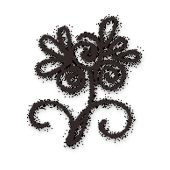Modern forms of preserving the tradition
The tradition of sand pattern sprinkling survived in Kuyavia till this day thanks to various activities taken from the mid 1960s until this day by cultural institutions of our region which contribute to preserving and promoting local traditions. It became one of the most characteristic and recognised elements of Kuyavian culture. The custom, however, being separated from its previous context and function, became more theatricalised also because of its location and the whole arrangement. The presentations of the tradition are usually arranged in museums or even in public spaces of cities. The women artists who perform sand sprinkling art often wear festive Kuyavian clothing, thus underlining their regional association. One example is the family of embroideress and folk poet Zofia Szamajda-Mierzwicka who cultivates Kuyavian traditions till this day and passes them from one generation to another. Zofia, despite her senior age, actively takes part in sand pattern sprinkling demonstrations with her daughter Róża and her grand-daughter Anita, who, because of their fascination in this form of art, have been learning it since childhood.

Prezentacje wysypywania piaskowych wzorów towarzyszą wielu imprezom folklorystycznym odbywającym się m.in. w Muzeum Etnograficznym im. Marii Znamierowskiej-Prüfferowej w Toruniu, w Muzeum Ziemi Kujawskiej i Dobrzyńskiej we Włocławku czy na Festiwalu Folkloru Kujaw i Ziemi Dobrzyńskiej.
Konkursy na Kujawskie sypanie piaskiem są organizowane regularnie od 1998 roku przez Miejsko-Gminny Ośrodek Kultury w Przedczu (woj. wielkopolskie). Biorą w nich udział nie tylko dorośli, ale też dzieci i młodzież. Do konkursu coraz częściej przystępują także mieszkańcy Wielkopolski z terenów sąsiadujących z Kujawami. Najmłodsi kontynuatorzy zwyczaju mogą też doskonalić swoje umiejętności na warsztatach uczących sypania piaskowych wzorów organizowanych przez tę placówkę.
The presentations of sand pattern sprinkling accompany many folklore events which take place for example in the Maria Znamierowska-Prüfferowa Ethnographic Museum in Toruń, in the Kuyavia and Dobrzyń Land Museum in Włocławek and on the Kuyavia and Dobrzyń Land Folklore Festival.
The Kuyavian Sand Sprinkling competitions have been organised regularly since 1998 by the Municipal Culture Centre in Przedecz (Greater Poland Province). Not only adults but also children and teenagers participate in them. The inhabitants of Greater Poland regions neighbouring Kuyavia take part in the competition more and more often. The youngest participants who continue the tradition can learn at the sand pattern sprinkling workshops organised by this establishment.
Thanks to its visual attractiveness, this old form of folk decorative art is becoming more and more popular among modern spectators of shows and competitions which allow active participation by creating own sand compositions. It was appreciated by including it in the unique elements of the intangible heritage of Kuyavia which should be preserved and promoted in order to shape regional identity which is a significant component of our national culture.
Sand Pattern Sprinkling. Modern Times, Toruń, Przedecz, 2017,
production by: B. Olszewska, B. Oleszek,
4:30 min


